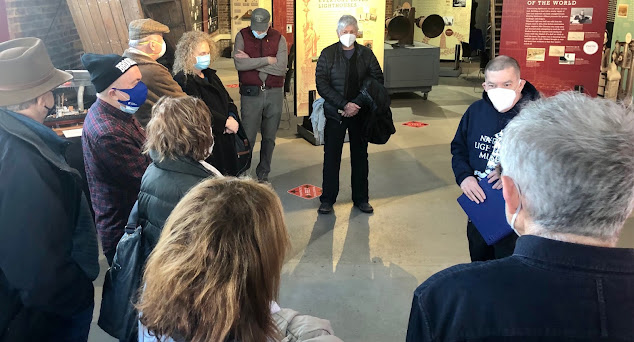As more and more snow makes the wooded trails impassible (or at least unpleasant) with shush or ice, Dave has scheduled more "urban expeditions". Six us us, including Lene and I, met at Adam Clayton Powell Boulevard (originally Sixth Ave) and 110th St, in Harlem. That is the Manhattan neighborhood where our Club was first located, when it was founded in the 1880's, We made the loop of the closed and plowed road, counterclockwise around most of the interior of Central Park. Well Lene and I got off at 59th Street to take the subway home. but the rest of them were more intrepid.
The next week ten of us met at the Staten Island Ferry terminal at the Battery for a free boat ride to the United States Lighthouse Museum. a seven minute walk from the S.I. terminal. Here are all of us except your photographer (Lene had other plans that day) listening raptly to the excellent talk by Jim Sarlo, the Museum's enthusiastic and knowledgeable Supervisor. His card describes him as an "Avocational Historian" and he jammed his free illustrated talk with many little known facts about lighthouses and Staten Island.
The two snow days were different from each other.
The first involved a lot of powdery snow, most of which had blown off. Getting off the remainder took only five minutes. But I stayed a total of four hours to complete the electrical projects. As previously reported, I replaced the sockets behind the switch plates in the salon because plugs inserted into the old ones frequently fell out -- way too easily. The other two electrical projects were the battery tangs and the wires to the water maker switch. Neither were broken; this was preventive maintenance before the damage could occur. I made the battery job a bit more difficult for myself by not taking photos before taking the tangs off the battery posts of the seven batteries. This caused me to worry at night about how to put Humpty Dumpty back together again. But years ago I had drawn a map showing all the wires attaching the batteries to the boat and to each other, which I was able to find at home. It saved the day. I crimped a new small ring tab to one thin wire of the pair connecting the solar panel regulator to the batteries; thin wires because they are short runs and do not carry much electricity at any one time, just a steady flow charging the batteries whilst the sun shines. And I took off, emery clothed, vaselined, reattached and bolted down the many battery cables involved for the four aft-most of the six six-volt house batteries. Then its just putting away all the tools, replacing the boards atop all the batteries upon which the aft cabin mattress lies and that job was done.
Next, we go forward to the other end of the boat: to the forward head and its hatch leading even further forward to the anchor locker. Strong task lighting and the small portable electric space heater moved into that small confined space with the door between the head and the forward berth closed most of the time (except for the times when I had to go aft to find a replacement nut for the one that I dropped into the anchor locker and again to turn on and off the water maker switch by the electrical panel to make sure that the new electrical connection was solid) made for a warm enough work environment, even without the short bursts of concentrated heat from the heat gun that shrank the shrink wrap tube over the new splice to keep out water.
The heat gun did its work and I rotated a fastener 90 degrees to accept a wire tie to pull the top of the heat shrunk closed joints to the top of an inverted "U". The red and yellow on the right side come from the batteries, while the red and black to the left go to the switch.

